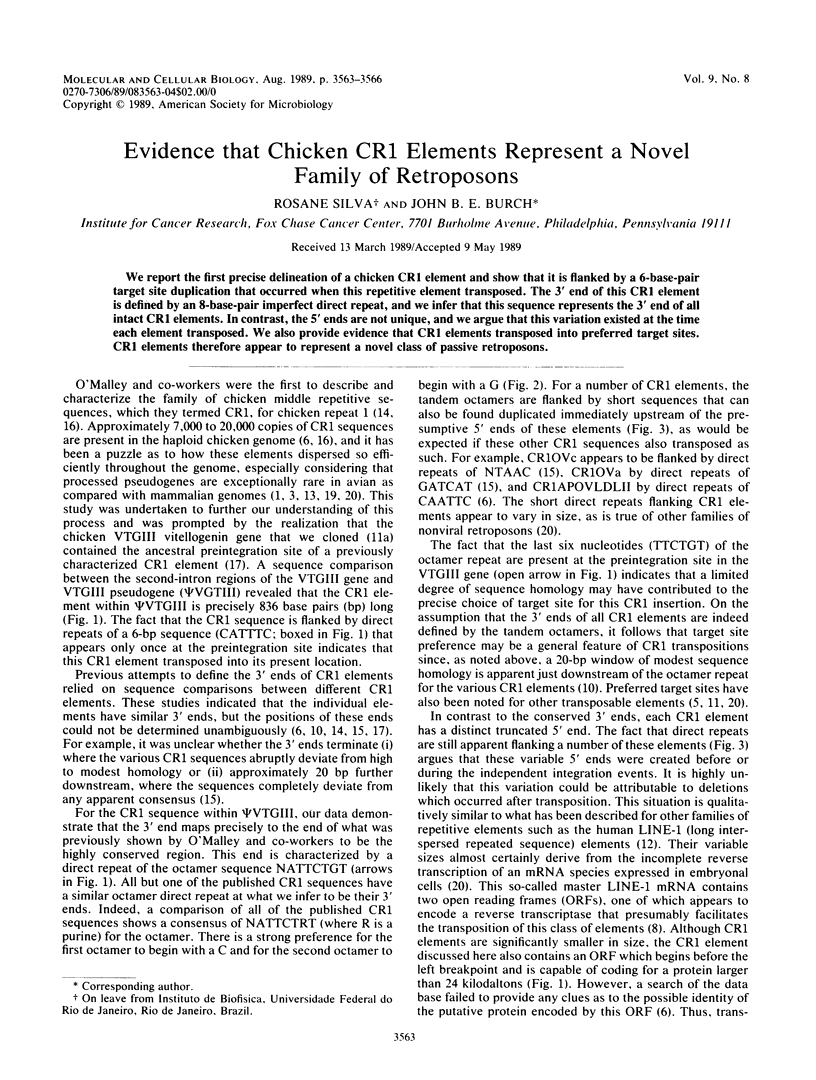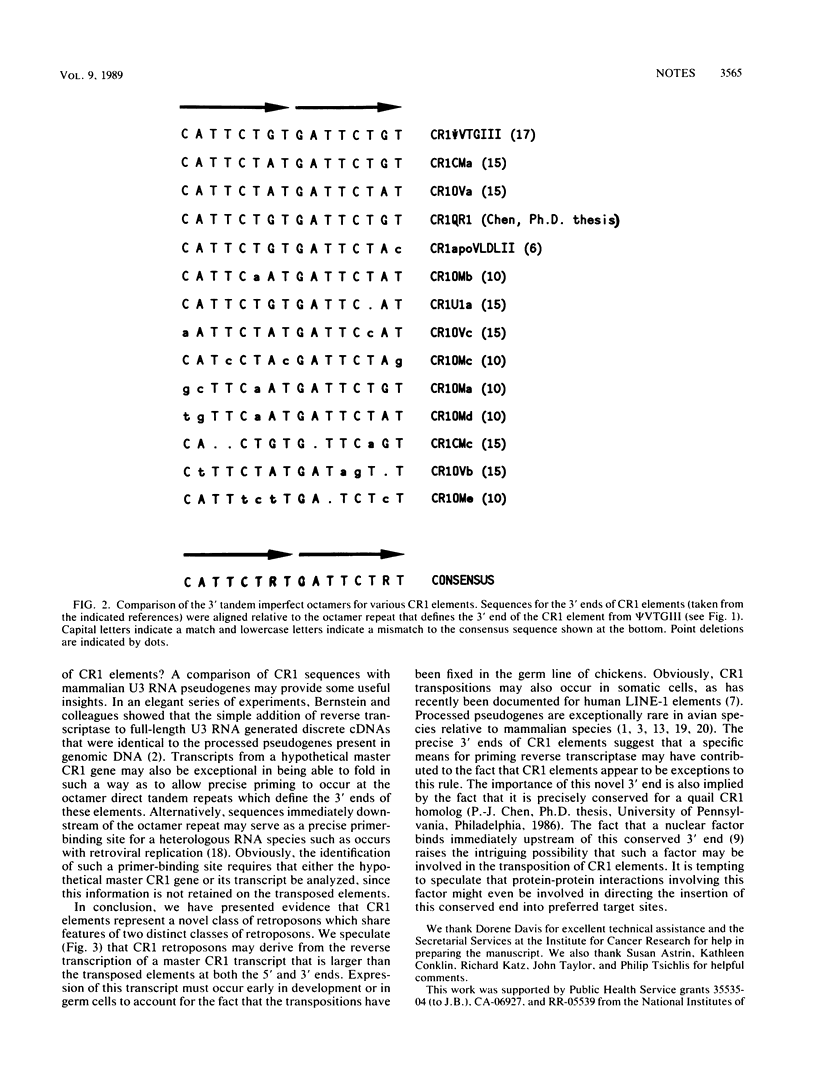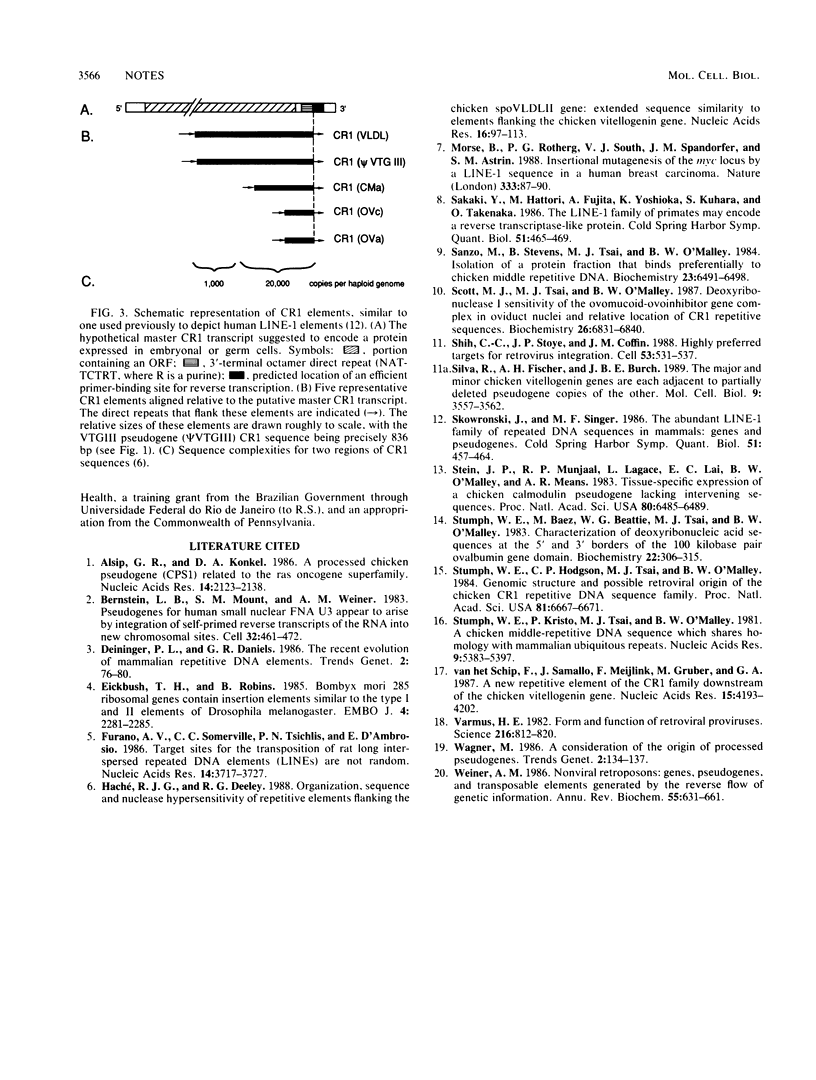Abstract
We report the first precise delineation of a chicken CR1 element and show that it is flanked by a 6-base-pair target site duplication that occurred when this repetitive element transposed. The 3' end of this CR1 element is defined by an 8-base-pair imperfect direct repeat, and we infer that this sequence represents the 3' end of all intact CR1 elements. In contrast, the 5' ends are not unique, and we argue that this variation existed at the time each element transposed. We also provide evidence that CR1 elements transposed into preferred target sites. CR1 elements therefore appear to represent a novel class of passive retroposons.
Full text
PDF



Selected References
These references are in PubMed. This may not be the complete list of references from this article.
- Alsip G. R., Konkel D. A. A processed chicken pseudogene (CPS1) related to the ras oncogene superfamily. Nucleic Acids Res. 1986 Mar 11;14(5):2123–2138. doi: 10.1093/nar/14.5.2123. [DOI] [PMC free article] [PubMed] [Google Scholar]
- Bernstein L. B., Mount S. M., Weiner A. M. Pseudogenes for human small nuclear RNA U3 appear to arise by integration of self-primed reverse transcripts of the RNA into new chromosomal sites. Cell. 1983 Feb;32(2):461–472. doi: 10.1016/0092-8674(83)90466-x. [DOI] [PubMed] [Google Scholar]
- Eickbush T. H., Robins B. Bombyx mori 28S ribosomal genes contain insertion elements similar to the Type I and II elements of Drosophila melanogaster. EMBO J. 1985 Sep;4(9):2281–2285. doi: 10.1002/j.1460-2075.1985.tb03927.x. [DOI] [PMC free article] [PubMed] [Google Scholar]
- Furano A. V., Somerville C. C., Tsichlis P. N., D'Ambrosio E. Target sites for the transposition of rat long interspersed repeated DNA elements (LINEs) are not random. Nucleic Acids Res. 1986 May 12;14(9):3717–3727. doi: 10.1093/nar/14.9.3717. [DOI] [PMC free article] [PubMed] [Google Scholar]
- Haché R. J., Deeley R. G. Organization, sequence and nuclease hypersensitivity of repetitive elements flanking the chicken apoVLDLII gene: extended sequence similarity to elements flanking the chicken vitellogenin gene. Nucleic Acids Res. 1988 Jan 11;16(1):97–113. doi: 10.1093/nar/16.1.97. [DOI] [PMC free article] [PubMed] [Google Scholar]
- Morse B., Rotherg P. G., South V. J., Spandorfer J. M., Astrin S. M. Insertional mutagenesis of the myc locus by a LINE-1 sequence in a human breast carcinoma. Nature. 1988 May 5;333(6168):87–90. doi: 10.1038/333087a0. [DOI] [PubMed] [Google Scholar]
- Sakaki Y., Hattori M., Fujita A., Yoshioka K., Kuhara S., Takenaka O. The LINE-1 family of primates may encode a reverse transcriptase-like protein. Cold Spring Harb Symp Quant Biol. 1986;51(Pt 1):465–469. doi: 10.1101/sqb.1986.051.01.056. [DOI] [PubMed] [Google Scholar]
- Sanzo M., Stevens B., Tsai M. J., O'Malley B. W. Isolation of a protein fraction that binds preferentially to chicken middle repetitive DNA. Biochemistry. 1984 Dec 18;23(26):6491–6498. doi: 10.1021/bi00321a034. [DOI] [PubMed] [Google Scholar]
- Scott M. J., Tsai M. J., O'Malley B. W. Deoxyribonuclease I sensitivity of the ovomucoid-ovoinhibitor gene complex in oviduct nuclei and relative location of CR1 repetitive sequences. Biochemistry. 1987 Oct 20;26(21):6831–6840. doi: 10.1021/bi00395a037. [DOI] [PubMed] [Google Scholar]
- Shih C. C., Stoye J. P., Coffin J. M. Highly preferred targets for retrovirus integration. Cell. 1988 May 20;53(4):531–537. doi: 10.1016/0092-8674(88)90569-7. [DOI] [PubMed] [Google Scholar]
- Silva R., Fischer A. H., Burch J. B. The major and minor chicken vitellogenin genes are each adjacent to partially deleted pseudogene copies of the other. Mol Cell Biol. 1989 Aug;9(8):3557–3562. doi: 10.1128/mcb.9.8.3557. [DOI] [PMC free article] [PubMed] [Google Scholar]
- Skowronski J., Singer M. F. The abundant LINE-1 family of repeated DNA sequences in mammals: genes and pseudogenes. Cold Spring Harb Symp Quant Biol. 1986;51(Pt 1):457–464. doi: 10.1101/sqb.1986.051.01.055. [DOI] [PubMed] [Google Scholar]
- Stein J. P., Munjaal R. P., Lagace L., Lai E. C., O'Malley B. W., Means A. R. Tissue-specific expression of a chicken calmodulin pseudogene lacking intervening sequences. Proc Natl Acad Sci U S A. 1983 Nov;80(21):6485–6489. doi: 10.1073/pnas.80.21.6485. [DOI] [PMC free article] [PubMed] [Google Scholar]
- Stumph W. E., Baez M., Beattie W. G., Tsai M. J., O'Malley B. W. Characterization of deoxyribonucleic acid sequences at the 5' and 3' borders of the 100 kilobase pair ovalbumin gene domain. Biochemistry. 1983 Jan 18;22(2):306–315. doi: 10.1021/bi00271a012. [DOI] [PubMed] [Google Scholar]
- Stumph W. E., Hodgson C. P., Tsai M. J., O'Malley B. W. Genomic structure and possible retroviral origin of the chicken CR1 repetitive DNA sequence family. Proc Natl Acad Sci U S A. 1984 Nov;81(21):6667–6671. doi: 10.1073/pnas.81.21.6667. [DOI] [PMC free article] [PubMed] [Google Scholar]
- Stumph W. E., Kristo P., Tsai M. J., O'Malley B. W. A chicken middle-repetitive DNA sequence which shares homology with mammalian ubiquitous repeats. Nucleic Acids Res. 1981 Oct 24;9(20):5383–5397. doi: 10.1093/nar/9.20.5383. [DOI] [PMC free article] [PubMed] [Google Scholar]
- Varmus H. E. Form and function of retroviral proviruses. Science. 1982 May 21;216(4548):812–820. doi: 10.1126/science.6177038. [DOI] [PubMed] [Google Scholar]
- Weiner A. M., Deininger P. L., Efstratiadis A. Nonviral retroposons: genes, pseudogenes, and transposable elements generated by the reverse flow of genetic information. Annu Rev Biochem. 1986;55:631–661. doi: 10.1146/annurev.bi.55.070186.003215. [DOI] [PubMed] [Google Scholar]
- van het Schip F., Samallo J., Meijlink F., Gruber M., AB G. A new repetitive element of the CR1 family downstream of the chicken vitellogenin gene. Nucleic Acids Res. 1987 May 26;15(10):4193–4202. doi: 10.1093/nar/15.10.4193. [DOI] [PMC free article] [PubMed] [Google Scholar]


